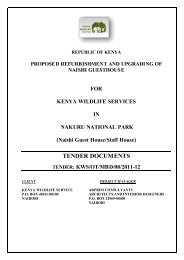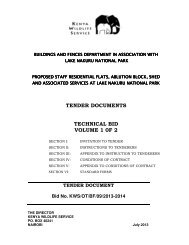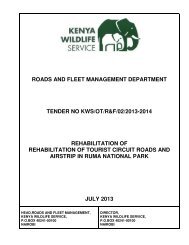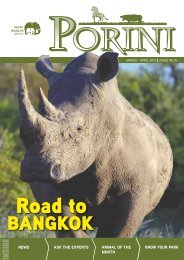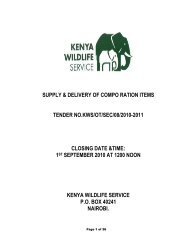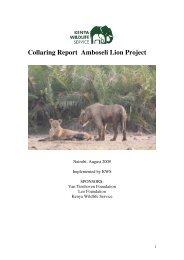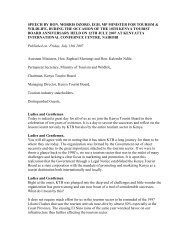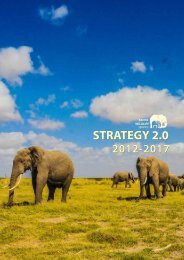Conservation and Management Strategy for the Elephant in Kenya
Conservation and Management Strategy for the Elephant in Kenya
Conservation and Management Strategy for the Elephant in Kenya
You also want an ePaper? Increase the reach of your titles
YUMPU automatically turns print PDFs into web optimized ePapers that Google loves.
52 CONSERVATION AND MANAGEMENT STRATEGY FOR THE ELEPHANT IN KENYA<br />
3.3.5 Incentives<br />
[ BELOW ] Plate 37.<br />
Beehive fences protect<strong>in</strong>g farms near<br />
Tsavo West NP - Lucy K<strong>in</strong>g, Save <strong>the</strong> <strong>Elephant</strong>s<br />
Provide benefits that will<br />
encourage l<strong>and</strong>owners<br />
<strong>and</strong> local communities<br />
to tolerate, protect <strong>and</strong><br />
accommodate elephants.<br />
Rationale <strong>and</strong> considerations<br />
Conv<strong>in</strong>c<strong>in</strong>g communities to live <strong>in</strong> coexistence with elephants will take more than education <strong>and</strong> awareness<br />
<strong>and</strong> a commitment to conservation of a species; it will require security of life, property <strong>and</strong> crops, <strong>and</strong> compensation<br />
to mitigate loss. It will require <strong>the</strong> provision of tangible benefits, directly l<strong>in</strong>ked to <strong>the</strong> presence of elephants, which<br />
will <strong>in</strong>crease tolerance <strong>and</strong> custodianship of elephants among people that own <strong>and</strong> use l<strong>and</strong> outside of <strong>the</strong><br />
government PA network, where much of <strong>the</strong> exist<strong>in</strong>g <strong>and</strong> potential range <strong>for</strong> elephants <strong>in</strong> <strong>Kenya</strong> occurs.<br />
The provision of adequate compensation <strong>for</strong> losses suffered has had difficulties: <strong>the</strong> enormous potential cost,<br />
<strong>the</strong> shortfall <strong>in</strong> expectations by those affected <strong>and</strong> <strong>the</strong> prevalent <strong>in</strong>cidence of false-report<strong>in</strong>g. It is also counter<br />
to government policy. An alternative approach is ‘consolation’ payment, which is not <strong>in</strong>tended to substitute <strong>the</strong><br />
market value <strong>for</strong> <strong>the</strong> loss, but as a gesture of goodwill. These schemes have had some limited success <strong>in</strong> reduc<strong>in</strong>g<br />
tensions between people <strong>and</strong> elephants as <strong>the</strong>y are often dependent on <strong>the</strong> availability of external fund<strong>in</strong>g sources,<br />
through NGOs <strong>and</strong> committed <strong>in</strong>dividuals. Thus, <strong>the</strong>ir long-term susta<strong>in</strong>ability is open to question.<br />
More susta<strong>in</strong>able approaches need to be explored, such as environmental risk <strong>in</strong>surance schemes as part of a<br />
framework of support to rural livelihoods (Sachs, 2007). Such schemes, which are rooted <strong>in</strong> rural development<br />
programmes, could be developed <strong>in</strong> comb<strong>in</strong>ation with micro-f<strong>in</strong>ance approaches l<strong>in</strong>ked to conservation-friendly<br />
<strong>in</strong>vestment opportunities, to improve <strong>and</strong> diversify local livelihoods. O<strong>the</strong>r approaches <strong>in</strong>clude community<br />
self-<strong>in</strong>surance schemes. The levels of compensation <strong>and</strong> contributions are set, <strong>and</strong> <strong>in</strong>vestigations <strong>and</strong> payments are<br />
undertaken by community members <strong>the</strong>mselves, with support from NGOs <strong>and</strong> government. A similar approach is<br />
underway <strong>in</strong> relation to compensation <strong>for</strong> predation on livestock <strong>in</strong> sou<strong>the</strong>rn Kajiado District, <strong>Kenya</strong>. Such<br />
approaches, where <strong>the</strong> local citizens <strong>the</strong>mselves are <strong>in</strong> charge of <strong>the</strong> programme, have a greater likelihood of<br />
success. There is scope <strong>for</strong> broaden<strong>in</strong>g <strong>the</strong> <strong>in</strong>volvement <strong>in</strong> compensation funds of o<strong>the</strong>r stakeholders, who are<br />
beneficiaries of wildlife <strong>in</strong> <strong>Kenya</strong> – o<strong>the</strong>r l<strong>and</strong> owners, private sector commercial tourism operators <strong>and</strong> higher level<br />
organisations, such as airl<strong>in</strong>es, hotel groups <strong>and</strong> suppliers to <strong>the</strong> tourism <strong>in</strong>dustry.<br />
The generation <strong>and</strong> stream<strong>in</strong>g of positive benefits to l<strong>and</strong>owners, <strong>in</strong>clud<strong>in</strong>g promotion of rational <strong>and</strong> collaborative<br />
plann<strong>in</strong>g of l<strong>and</strong> use <strong>in</strong> elephant range, is important. Incentives will need to be present at many levels; government,



